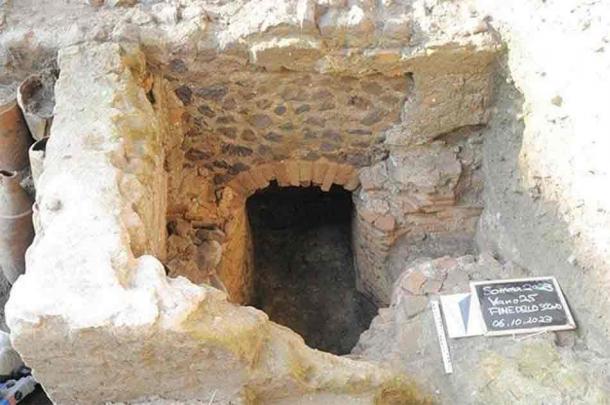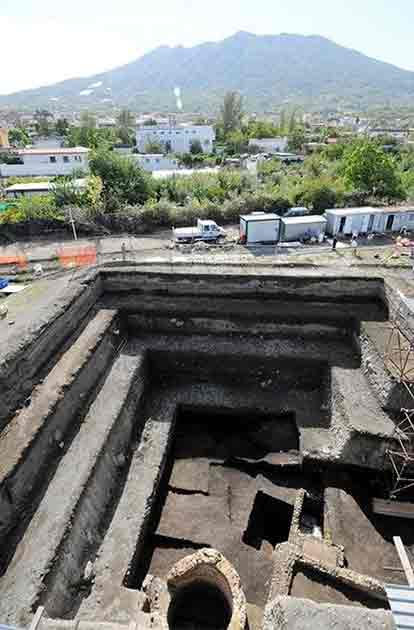🔴 Website 👉 https://u-s-news.com/
Telegram 👉 https://t.me/usnewscom_channel
Archaeologists from the University of Tokyo has excavated what may be the remains of the Villa of Augustus, a first-century grand estate that was built near Somma Vesuviana, a town located in the greater Naples area in southern Italy. This is where the first Roman emperor, the legendary Augustus Caeser, was said to have died in the year 14 AD.
Augustus’ villa was constructed on the northern side of Mount Vesuvius, and like so much else in the vicinity it was buried under tons of volcanic ash and molten lava following the catastrophic eruption of this volcano in 79 AD. The search for the famed Villa of Augustus has been going on for decades, which is why the announcement by the Japanese archaeologists that they may have found it is generating so much excitement.
The remains of what is believed to be a furnace used to heat a bath at the Somma Vesuviana site. (Institute for Advanced Global Studies, University of Tokyo, Komaba)
Is This Really the Villa of Augustus? Examining the Evidence
In the 1930s, other excavations at the same location north of Mount Vesuvius unearthed the remains of a Roman-era estate that many assumed was the long-buried villa. But later investigations proved these ruins dated to the second century AD, meaning it had been built after Mount Vesuvius had already erupted.
The newest excavations penetrated below this estate, and this led to the surprising discovery that it had been erected over the top of an older residence. The University of Tokyo archaeologists who found the earlier structure have been able to demonstrate that Mount Vesuvius was responsible for its burial, and they’ve also shown that the estate definitely dates to the early first century AD.
They performed radiocarbon dating tests on organic materials recovered from the site that confirmed the latter fact, and they carried out a chemical analysis of the volcanic rock covering the villa to prove it had come from Vesuvius.
What has been observed during the excavations so far reveals that the villa would have belonged to a powerful and uber-wealthy person. The architecture is in the typical ancient Roman style favored by elites, and the structure features a room that seems to have been reserved for a private bath, which is an installation Augustus would have undoubtedly had.
The excavation site at Somma Vesuviana. (Institute for Advanced Global Studies, University of Tokyo, Komaba)
The Japanese archaeologists also found evidence showing that a kiln had been built onsite in an adjacent structure. Deposits of charcoal were found in this location, and it was radiocarbon dating results obtained from these that proved the estate was occupied in the early first century.
Notably, there is no evidence to suggest the kiln was in use beyond this time. This would be expected if the villa had belonged to Augustus, since his estate was essentially abandoned after his death. Also, it seems a large temple-like structure was constructed over the top of the villa site sometime before the eruption of Mount Vesuvius. This suggests that some type of redevelopment project was launched after the villa was abandoned by its owner, one that was presumably interrupted by the volcanic event that is best remembered for completely burying the Roman city of Pompeii.
While its characteristics are consistent with the theory that the newly excavated villa was Augustus’ home away from Rome, more investigation will be required to verify this assertion with 100-percent certainty. In Roman Empire times, Somma Vesuviana was a popular resort area for the rich and powerful, and many Roman elites built luxurious homes in the area.
Sensing the implications for local tourism, officials in Somma Vesuviana are already looking ahead. Mayor Salvatore Di Sarno issued a statement expressing his delight with the new discovery, while detailing the town’s future plans for the site.
“We are one step away from history. What came to light in Somma could be part of the Villa of Augustus,” the Mayor said in a statement published by Napoli Today. “With the financed projects we are aiming for the urban redevelopment of that area. We hope to open the Villa Augustus at least every first Sunday of the month, every month.”
What Mount Vesuvius Buried, Only Archaeologists Can Resurrect
In addition to the possible discovery of the Villa of Augustus, the most recent excavations have also provided fascinating information about the impact of the volcanic eruption of 79 AD.
Previously, most archaeologists believed that extreme devastation had only been experienced on the south side of Mount Vesuvius, where the doomed cities of Pompeii and Herculaneum were located. But during the excavations at Somma Vesuviana archaeologists have found signs of heavy destruction, including collapsed walls and widely scattered roof tiles.
This type of damage, plus the relatively deep burial of the villa site, shows that dense lava flows must have covered the northern foothills surrounding Mount Vesuvius soon after it erupted. The Villa of Augustus couldn’t possibly have survived such a disaster, any more than the homes of the elite who resided in Pompeii.
After Augustus Caesar’s 41-year reign as Rome’s first emperor ended with his death in 14 AD, there was allegedly a memorial built near his home in honor of his accomplishments as the founder of the Roman Empire. If excavations in and around the newly discovered villa eventually find the remnants of this project, this could function as absolute proof that the estate did in fact belong to the great Augustus Caesar. Explorations at the site will be continuing, raising hope that such proof will be forthcoming.
Top image: Left; The excavation site at Somma Vesuviana. Credit: Right; Augustus Caesar of Prima Porta statue. Source: Left; University of Tokyo Foundation. Right; Vatican Museums/CC BY-SA 4.0
By Nathan Falde


